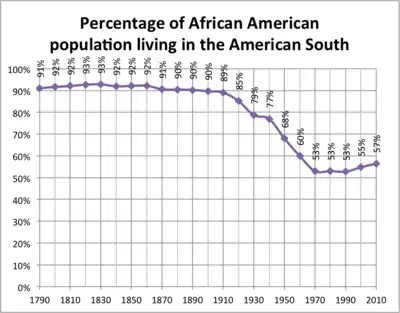New Great Migration
The New Great Migration is the demographic change from 1970 to the present, which is a reversal of the previous 55-year trend of black migration within the United States. Since 1970, deindustrialization of cities in the Northeastern and Midwestern United States, growth of jobs in the "New South" with lower costs of living, family, kinship ties, improving racial relations and religious connections have all acted to attract African Americans to the Southern United States in substantial numbers.[1] Between 1965 and 1970 the Southern States lost around 287,000 African-Americans, while from 1975 to 1980 the South United States had a net gain of 109,000 African-Americans showing the reversal of the original Great Migration.[1] Between 1975 and 1980, several southern states saw net African-American migration gainers, while in 2014, African-American millennials moved in the highest numbers to Texas, Georgia, Florida, and North Carolina. [2] African-American populations have continued to drop throughout much of the Northeast, especially from the state of New York[2][3] and northern New Jersey,[4] as they rise in the South.

College graduates and middle-class migrants make up a major portion of the new migration. For instance, from 1965–2000, the states of Florida, Georgia, and Texas attracted the most black college graduates. The only state outside the former Confederacy that attracted a sizeable migration of black college graduates was Maryland, most of the population growth being in the counties surrounding Washington, D.C. In that same period, California was a net loser of black migration for the first time in three decades. While the migration is still in progress, much data is from this 35-year period.[5]
The New Great Migration is not evenly distributed throughout the South. As with the earlier Great Migration, the New Great Migration is primarily directed toward cities and large urban areas, such as Atlanta, Charlotte, Houston, Dallas, Raleigh, Washington, D.C., Tampa, Virginia Beach, San Antonio, Memphis, Orlando, Nashville, Jacksonville, and so forth. North Carolina's metro area, Charlotte, in particular is a hot spot for African-American migrants in the US. Between 1975 and 1980, Charlotte saw a net gain of 2,725 African-Americans in the area. This number continued to rise as between 1985 and 90 the area had a net gain of 7,497 African-American and from 1995 to 2000 the net gain was 23,313 African-Americans. This rise in net gain shows that Charlotte, North Carolina is a growing hot spot for the migrants of The New Great Migration.[1] Primary destinations are those states that have the most job opportunities, especially Georgia, North Carolina, Maryland, Virginia, Tennessee, Florida, and Texas. Other southern states, including Mississippi, Louisiana, South Carolina, Alabama, and Arkansas, have seen little net growth in the African American population from return migration.
While there are many financial causes of the New Great Migration, one more reason that is not talked about much is religion. Many migrants of the New Great Migration try to find a "sign of God" about moving and even those coming for job reasons will use faith to manage the feelings of uncertainty that come with moving states/jobs. Some migrants move to the South of the United States to get more connected to their faith and see the move as a "spiritual journey". This is not coming from nowhere as the southern states are often called the Bible Belt, because of the large number of churches and the heavy connection to Christianity in the area.[1]
See also
By city
By state
- African Americans in Alabama
- African Americans in Florida
- African Americans in Georgia (U.S. state)
- African Americans in Louisiana
- African Americans in Maryland
- African Americans in Mississippi
- African Americans in North Carolina
- African Americans in South Carolina
- African Americans in Tennessee
- History of African Americans in Texas
References
- Pendergrass, Sabrina (January 3, 2017) “No Longer ‘Bound for the Promised Land’: African Americans’ Religious Experiences in the Reversal of the Great Migration.” Race and Social Problems 9. Retrieved November 2 2020.
- Reniqua Allen (July 8, 2017). "Racism Is Everywhere, So Why Not Move South?". The New York Times. Retrieved July 9, 2017.
- Dan Bilefsky (June 21, 2011). "For New Life, Blacks in City Head to South". The New York Times. Retrieved July 9, 2017.
- Dave Sheingold via The Record (February 27, 2011). "North Jersey black families leaving for lure of new South". Charleston Gazette-Mail. Retrieved July 9, 2017.
- William H. Frey (May 2004). "The New Great Migration: Black Americans' Return to the South, 1965-to the present". Brookings Institution. brookings.edu. Retrieved July 10, 2017.